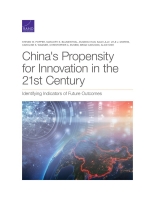by Steven W. Popper
Research Questions
How far will China be able to go toward achieving the pathbreaking innovation it seeks broadly across many sectors?
What information would be needed to better understand China's propensity for innovation and thus assess its trajectory in the coming decades?
How well might standard criteria for evaluation used in other technology-leading nations apply to a system affirmatively designed to follow a development path "with Chinese characteristics"?
The authors examine the propensity within China's innovation system to realize its potential as an innovating nation: What is the balance of systemic forces that incline toward seeing that the innovation assets China possesses lead to innovation outcomes? They lay out a conceptual framework for capturing the major activities, interactions, and flows that give rise to technological innovations. They use this framework to place within one matrix salient elements that appear in the global literature on innovation; the literature on innovation in China and on its political, economic, and social systems; the results from three case studies prepared for this report (pharmaceuticals, artificial intelligence, and distributed ledger technology); and three different inquiries into the nature and measurement of network organization. They then provide a determination of which cells in the matrix that result from placing these elements into the innovation framework might be most useful as windows into those aspects of China's innovation system dynamics that might be expected to affect innovation propensity and observed innovation outcomes.
Measures are developed for these elements with an emphasis more on what observers would like to know as opposed to what information might be most readily available presently. Thirteen of these indicators are then selected to form a preliminary "dashboard" of candidate indicators for China's propensity toward future innovation. These are offered not as final findings but rather as a first set of candidates to be assessed and refined in later empirical analyses. The authors also offer sample proxies for these draft indicators.
Key Findings
The conceptual framework was developed as an intellectual accounting system for factors affecting both innovation potential and innovation propensity. It is intended to be populated with the main elements of China's system for generating innovation, both "apples and oranges."
The candidate short list of indicators for China's innovation propensity was derived by sifting through existing relevant literatures, both academic literature as well as the "gray" literature found in journalism in print and online; conducting case studies of sectors selected for the contrast they could provide; and investigating possible measurement techniques.
Sectoral case studies reveal differences between the high priority artificial intelligence sector and lesser priority pharmaceuticals. Distributed ledger technology ("blockchain") was a field of early advantage for China in which policy and political considerations have worked to limit and stifle innovation.
Bibliometric analysis and review of patent data suggest China is advancing swiftly in academic publication, while patenting shows more priority on focused areas as opposed to the wide exploration of economic niches found in the United States.
A major policy thrust of China's party leadership has been to inculcate adherence to a model of development "with Chinese characteristics." Therefore, it is insufficient to presume similarity of institutional structure with prior innovation case studies. The nature of the system needs to be regarded explicitly and a presumed equivalency resisted.
Recommendations
Track developments in individual technology fields and sectors. However, a fuller picture of China's future accomplishments may be gained by also considering larger systemic and institutional issues at the sectoral, regional, and national levels.
Build a prospectus for examining China's system for generating innovation by determining what observable measures might be the early indicators or precursors that would allow for more accurately gauging the trajectory of China's rise to innovation prominence and how far it may go.
Consider important activities, factors, and venues for innovation in China; place them in an integrated framework; propose measures for the most important factors affecting the propensity toward innovation in China; and, from among these measures, select an initial "dashboard" of candidate indicators going forward and provide insights into the nature and dynamics of the changing system.

No comments:
Post a Comment